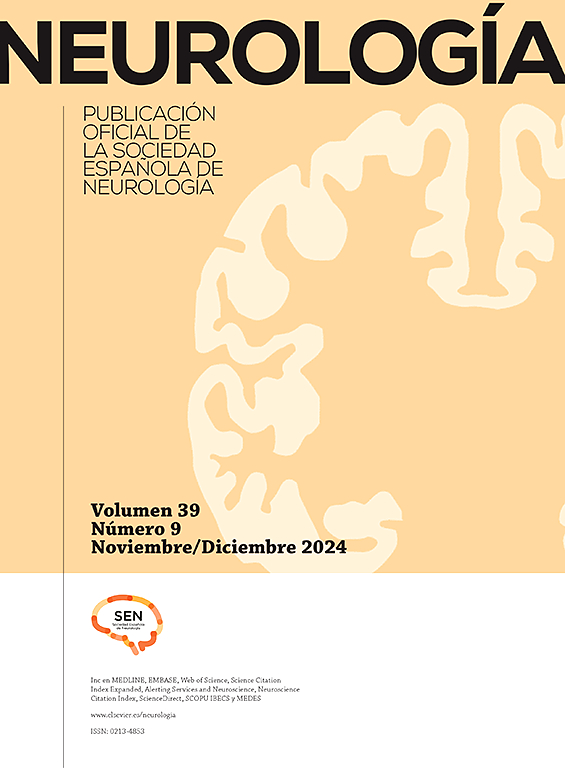Profundizando en la fatiga del síndrome post-COVID
IF 3.1
4区 医学
Q2 CLINICAL NEUROLOGY
引用次数: 0
Abstract
Introduction
More than 100 million people have been infected worldwide by the SARS-CoV-2 virus, which is responsible for an acute disease called COVID-19. Multiple studies have shown how various symptoms in these patients can persist for several months after resolution of the acute process, known as post-COVID syndrome. The neurological clinic is varied, but with constant presentation of fatigue.
Objective
Analyze post-COVID fatigue.
Methods
We present a single-center, prospective, case-control study comparing patients with fatigue in the context of a post-COVID syndrome with patients who have passed COVID-19 without post-COVID fatigue. A baseline record (April 2021) and a control record at 6 months were made. Clinical variables, fatigue questionnaires, sleep disorders, depression, anxiety, cognitive impairment and quality of life are recorded. Basic analyzes of the two visits are collected. In addition, a substudy of inflammatory (IL-6, IL-1β, TNF-α) and anti-inflammatory (IL-10) cytokines is performed.
Results
The fatigue of the patients measured by Chadler is of moderate and mixed intensity (physical and psychological). At 6 months, physical fatigue improves, but psychological fatigue does not. Significant differences were found in sleepiness, cognitive deterioration, anxiety and quality of life. Significant alterations are evident of TNF-α values, but not in the rest of the cytokines.
Conclusions
Patients with fatigue have a poorer quality of life, with improvement in control being observed at 6 months, which suggests a course that could be self-limiting, but this will have to be confirmed with longer studies.
加深后新型冠状病毒疲劳
全球有超过1亿人感染了SARS-CoV-2病毒,这种病毒会导致一种名为COVID-19的急性疾病。多项研究表明,这些患者的各种症状在急性过程(称为后covid综合征)消退后可以持续数月。神经科临床表现多样,但常表现为疲劳。目的分析冠状病毒感染后的疲劳症状。方法本研究采用单中心、前瞻性、病例对照研究,比较了COVID-19综合征后出现疲劳的患者与已通过COVID-19综合征但未出现后疲劳的患者。基线记录(2021年4月)和6个月时的对照记录。记录临床变量、疲劳问卷、睡眠障碍、抑郁、焦虑、认知障碍和生活质量。收集了两次访问的基本分析。此外,还进行了炎症(IL-6, IL-1β, TNF-α)和抗炎(IL-10)细胞因子的亚研究。结果Chadler测量的患者疲劳程度为中度和混合强度(生理和心理)。6个月时,身体疲劳有所改善,但心理疲劳没有。在嗜睡、认知衰退、焦虑和生活质量方面发现了显著差异。TNF-α值明显改变,但其余细胞因子无明显变化。结论疲劳患者的生活质量较差,在6个月时观察到控制的改善,这表明一个过程可能是自限性的,但这还需要更长的研究来证实。
本文章由计算机程序翻译,如有差异,请以英文原文为准。
求助全文
约1分钟内获得全文
求助全文
来源期刊

Neurologia
医学-临床神经学
CiteScore
5.90
自引率
2.60%
发文量
135
审稿时长
48 days
期刊介绍:
Neurología es la revista oficial de la Sociedad Española de Neurología y publica, desde 1986 contribuciones científicas en el campo de la neurología clínica y experimental. Los contenidos de Neurología abarcan desde la neuroepidemiología, la clínica neurológica, la gestión y asistencia neurológica y la terapéutica, a la investigación básica en neurociencias aplicada a la neurología. Las áreas temáticas de la revistas incluyen la neurologia infantil, la neuropsicología, la neurorehabilitación y la neurogeriatría. Los artículos publicados en Neurología siguen un proceso de revisión por doble ciego a fin de que los trabajos sean seleccionados atendiendo a su calidad, originalidad e interés y así estén sometidos a un proceso de mejora. El formato de artículos incluye Editoriales, Originales, Revisiones y Cartas al Editor, Neurología es el vehículo de información científica de reconocida calidad en profesionales interesados en la neurología que utilizan el español, como demuestra su inclusión en los más prestigiosos y selectivos índices bibliográficos del mundo.
 求助内容:
求助内容: 应助结果提醒方式:
应助结果提醒方式:


